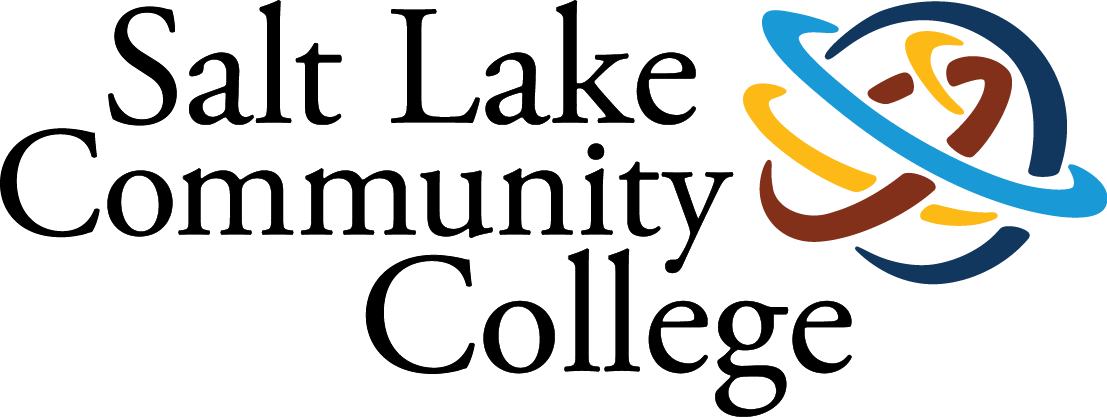6.2 Lab Protocol
Approximate Time: 3 hours
Learning Objectives
-
- Define Key Endocrine Terms: Define primary endocrine glands, ADH, oxytocin, TRH, CRH, GnRH, TSH, ACTH, and LH.
- Endocrine vs. Nervous Systems: Describe the differences between the endocrine and nervous systems.
- Hypothalamus-Pituitary Relationship: Explain the relationship between the hypothalamus and both the anterior and posterior pituitary glands.
- Tropic Hormones: Understand the role and function of tropic hormones.
- Hormonal Feedback Loops: Understand the feedback loops involved in regulating hormone release.
- Hormonal Actions: Understand the various actions of hormones at their target cells.
- Hormonal Pathways: Describe the pathways of the three hormones covered in this lab: thyroid hormones, cortisol, and testosterone.
- POPS Project:
- Materials and Methods section due.
- Students will collaborate on the Abstract for peer editing.
Activity 1A: Chemical classification of messengers
| Endocrine Organ | Hormone Released | Chemical Classification
(amino acid, amine, peptide/protein, steroid, eicosanoids) |
|---|---|---|
| Hypothalamus | TRH | |
| Anterior Pituitary | ACTH | |
| Posterior Pituitary | ADH | |
| Thyroid Gland | TH | |
| Adrenal Gland | Cortisol | |
| Pancreas | Insulin | |
| Testes | Testosterone | |
| Ovaries | Estradiol |
Table listing endocrine organs, the hormones they release, and their chemical classification. Includes hypothalamus (TRH), anterior pituitary (ACTH), posterior pituitary (ADH), thyroid gland (TH), adrenal gland (cortisol), pancreas (insulin), testes (testosterone), and ovaries (estradiol).
Activity 1B: Chemical Messengers
| Endocrine Organ | Hormone Released | Effect |
|---|---|---|
| Hypothalamus | TRH | |
| Anterior Pituitary | ACTH | |
| Posterior Pituitary | ADH | |
| Thyroid Gland | TH | |
| Adrenal Gland | Cortisol | |
| Pancreas | Insulin | |
| Testes | Testosterone | |
| Ovaries | Estradiol |
Table listing endocrine organs, the hormones they release, and their effects. Includes hypothalamus (TRH), anterior pituitary (ACTH), posterior pituitary (ADH), thyroid gland (TH), adrenal gland (cortisol), pancreas (insulin), testes (testosterone), and ovaries (estradiol).
Activity 2: Predict Impact of Hormone treatment on the organ weights and body weight
This exercise is designed to determine the identity of an unknown hormone by observing the effect it (the hormone) had on the organs of the male rat.
This activity was adapted from: Odenweller et. Al., LABORATORY EXERCISE USING ‘‘VIRTUAL RATS’’ TO
TEACH ENDOCRINE PHYSIOLOGY, AM. J. PHYSIOL. 273 (ADV. PHYSIOL. EDUC. 18): S24-S40, 1997.
The class should be divided into small groups of three or four students per group. Each student in the group should receive a copy of Table 1. Using the background material, the students should complete Table 1, in each column predicting the impact of specific hormone treatment on the weights of various organs. Not all hormones will have impacts on all organs. A + denotes an increase in size. A – denotes a decrease in size. Place the letters NC in the box where no change occurs. Leave the cell blank if the hormone is predicted to have to impact on the organ. Have your instructor check your predictions.
TABLE 1- Comparison of hormonal effects on organ weight and body weight (to be completed by students)
| TRH | TSH | ACTH | Cortisol | Testosterone intact | Testosterone castrate | LH intact | LH castrate | |
|---|---|---|---|---|---|---|---|---|
| Pituitary gland | ||||||||
| Thyroid gland | ||||||||
| Adrenal glands | ||||||||
| Thymus gland | ||||||||
| Testes | ||||||||
| Prostate gland | ||||||||
| Seminal vesicles | ||||||||
| Body weight |
**In each column, predict the impact of treatment with the indicated hormone on weight of the organs indicated. Not all organs will be impacted by all hormone treatments. A + denotes an increase in size. A – denotes a decrease in size. Place the letters NC in the box where no change occurs. TRH, thyrotropin-releasing hormone; TSH, thyroid stimulating hormone; ACTH, adrenocorticotropin hormone; LH, luteinizing hormone
Activity 3: Unknown Hormone
Identify unknown treatment hormone from autopsy data
After completing Table 1, the instructor will present each group with autopsy data from control rats and rats treated with an unknown hormone. The students will then use the background material, flowchart (from prelab reading), Table 1, and the autopsy data to determine the identity of the unknown hormone. At the end of class, the students will present their solution and rationale for their identification of their unknown hormone. If time permits, the students are encouraged to determine the identity of the remaining unknowns and provide a solution and rationale for each hormone.
The data for this laboratory were compiled from seven sets of male laboratory rats, two rats per set; one set was the control group and the remaining six were experimental groups. The rats were all male to simplify the study of the relationship between the reproductive and endocrine systems. In each set of rats there was an ‘‘intact’’ rat and a ‘‘castrate’’ rat. The castration involved removal of the testes to eliminate testosterone production. The two rats (normal and castrate) of each group were treated alike in all other ways (food, water, etc.). All rats, except for those in the control group were injected with a hormone on a daily basis for 2 weeks. Autopsies were performed on the animals at that time.
The group of students performing this laboratory experiment were very disorganized and rushed through the work, making errors in labeling the bottles of hormone. The students obtained the following results for organ weights after the autopsies were performed. In this short period of time, the students noted amazing changes in the size of certain organs when they compared the experimental group of rats with the control group. The bottles on the refrigerator shelf were ACTH, cortisol, LH, TSH, TRH, and testosterone.
Your group will be given data from a pair of control rats (intact and castrate) and a pair of experimental rats (intact and castrate). It is your group’s job to analyze the data and compare control and experimental data to determine which of the above hormones was used to treat your experimental rats. Using the background material, flowchart (Fig. 4), Table 1, and the autopsy data, match the unknown rat groups with their respective treatment hormones. If you don’t have time to assess the other experimental rats, be sure to listen to the rationale of other groups’ hormone identification.
To help in determining the identity of the unknown hormones, the student should look for changes between the control values and the values of the unknown hormone (both the intact and castrate animal). The changes between the control rats and the rats that were treated with the unknown hormone should be >20% if they are to be considered significantly different. If the change is <20%, it is attributed to experimental or biological error. Experimental errors may include small errors in calibration procedures, measurements, or instrumentation. Any variability that occurs because of the differences between animals is considered biological error.
Figure 1 below represents the organs of the rats used in the experiment.
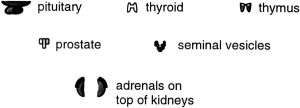
Figure 1: Graphic representation of organs studied in the autopsy, pituitary, thyroid, thymus, prostate, seminal vesicles, adrenals on top of kidneys.
Control Rats
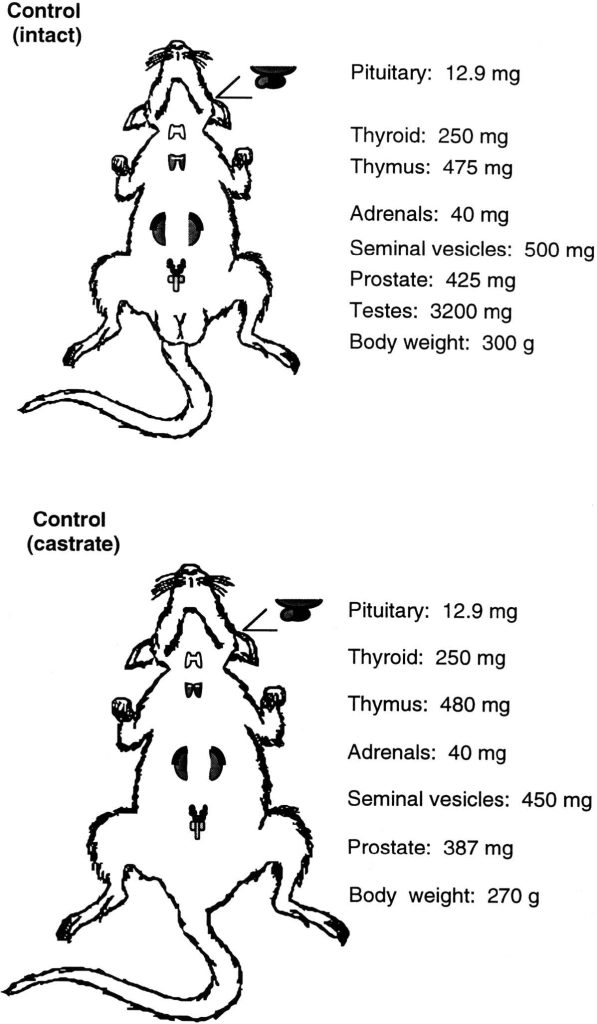
Experimental Rats
Hormone 1: __________
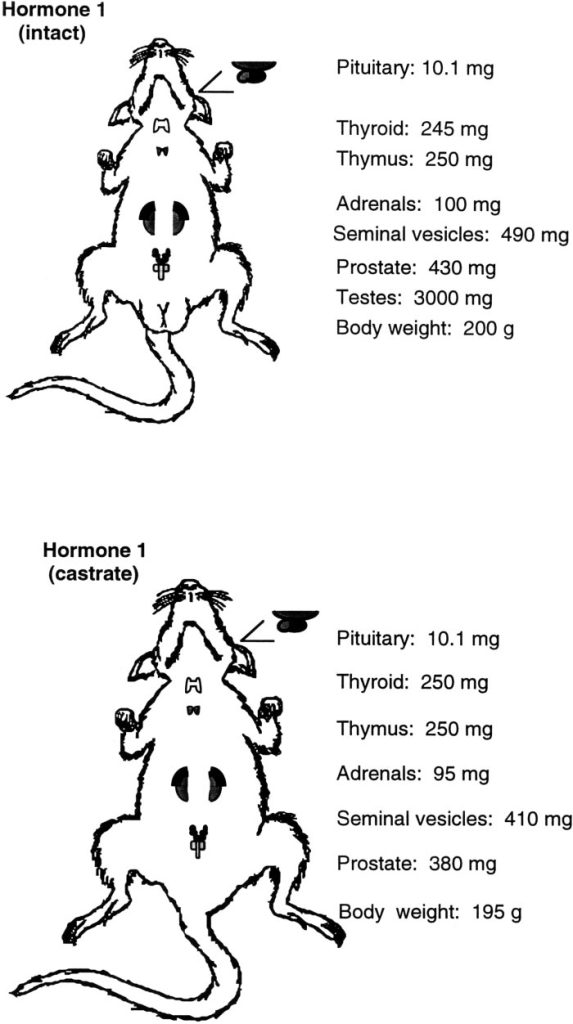
Hormone 2: ___________
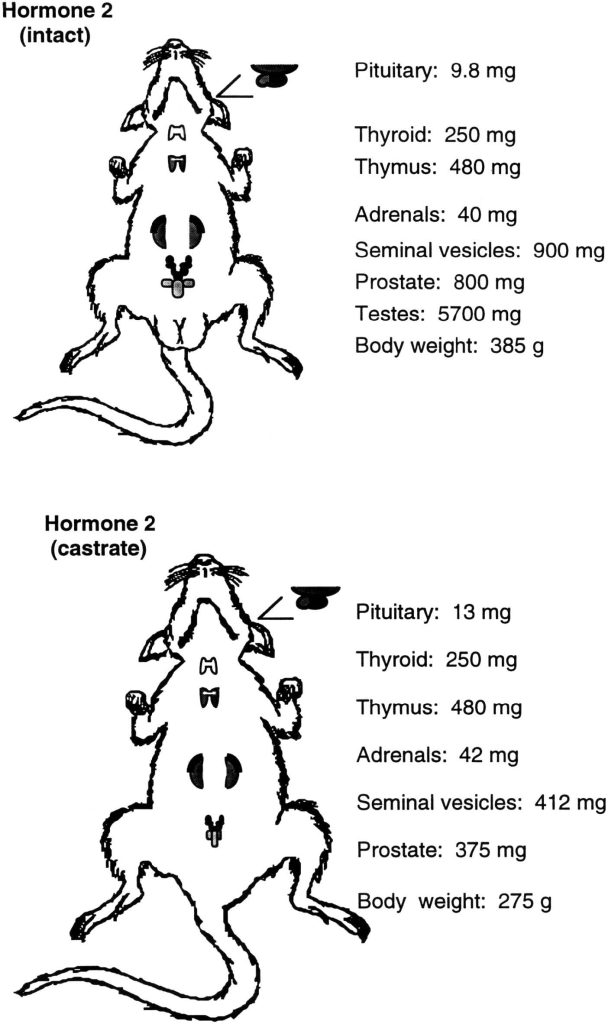
Hormone 3: _________

Hormone 4: _________
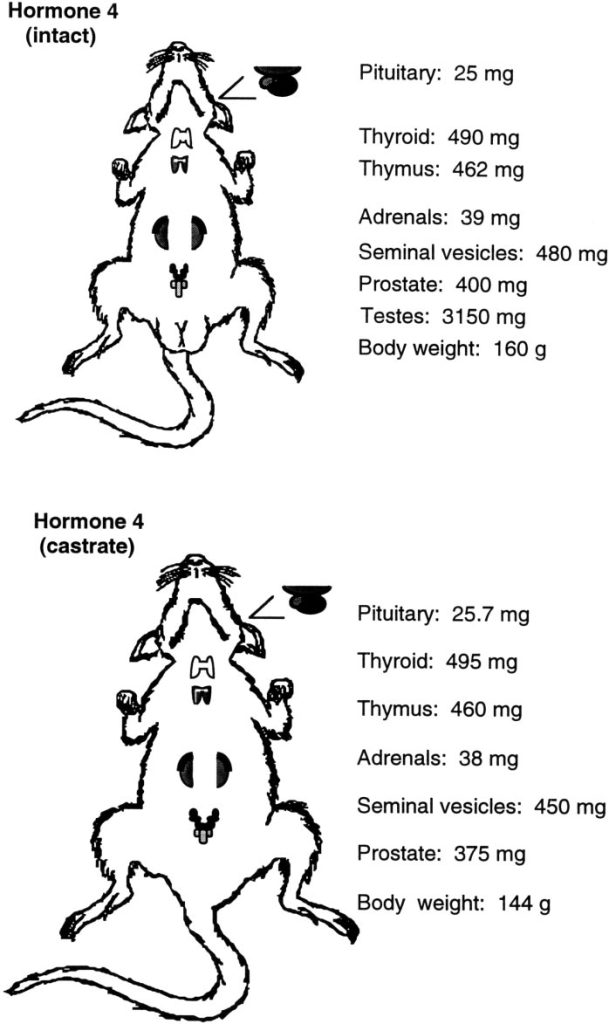
Hormone 5: __________
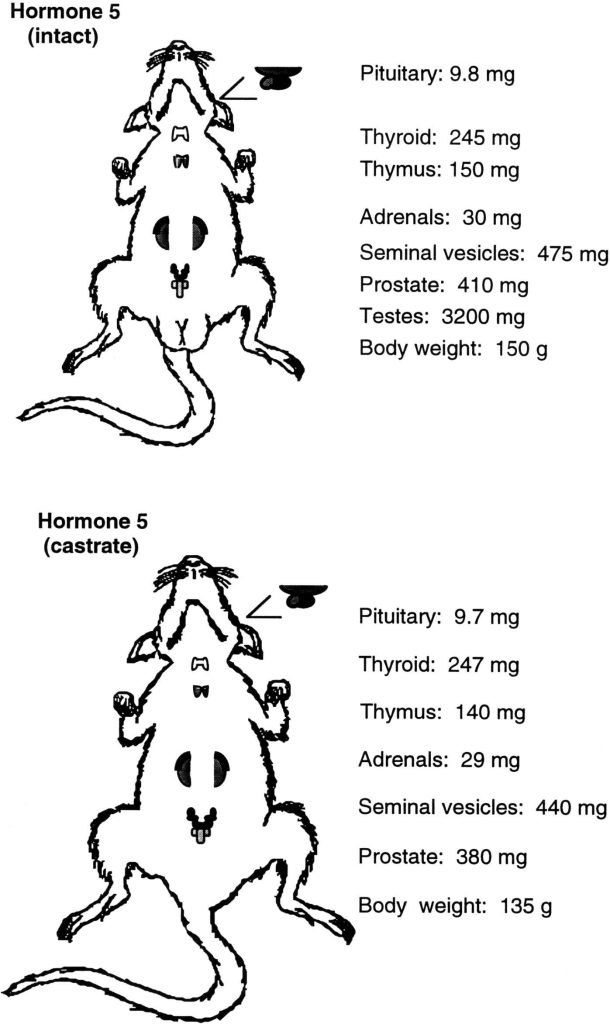
Hormone 6: __________
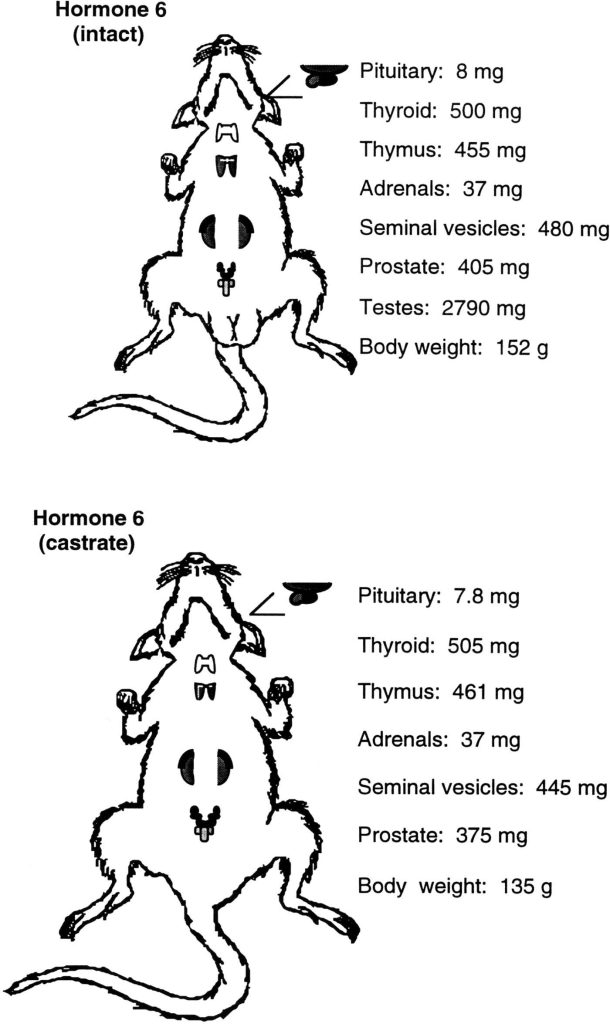
This Week’s focus for the POPS Project Includes:
- Materials and Methods Submission: Due at the end of lab.
- POPS Check-off: Abstract
- The student responsible for the Abstract section of POPS project should share it with the group for peer editing during lab. The final version of this section must be submitted by the end of the next lab.
